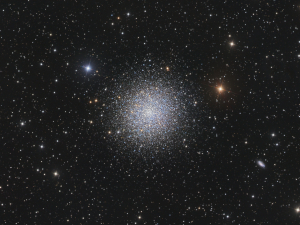The globular clusters in the halo of our galaxy are the oldest galactic objects for which reliable ages have been determined and are thought to be the first structures to form in the early history of the galaxy. Thus, they provide information about the early galaxy and place a lower limit on the age of the universe. In addition their ages may also provide the most stringent bound on the amount of dark matter in the universe. An example of an old cluster, M13, in the constellation Hercules, is shown below.
Globular clusters represent fascinating puzzles, particularly since it was discovered that they consist of multiple populations of stars. Distinct populations within a given globular cluster manifest themselves by discrete tracks in the color-magnitude diagram and a negative correlation (anticorrelation) of abundances between pairs of light elements, such as C-N, O-Na, Mg-Al, and Mg-K. Since the anticorrelations are mostly absent in halo field stars, their origin must be related to the poorly understood processes of globular-cluster and early-galaxy formation. The abundance anticorrelations have been detected both in red giants and in unevolved stars. Since these low-mass stars cannot produce the high temperatures required to alter the abundances of O, Na, Mg, Al, or K, the reported abundance anomalies likely originate from an earlier (i.e., first-generation) stellar population that subsequently polluted the matter out of which the currently observed second-generation globular cluster stars formed.
The observations confront us with a number of crucial questions. How many star-forming episodes took place in globular clusters? How does the process of star formation in a dense cluster environment differ from that in a molecular cloud devoid of stars? What kind of first-generation stars gave rise to the abundance anticorrelations and what was their composition? The measured abundance anticorrelations differ in magnitude from cluster to cluster, even among the clusters that show no significant spread in the iron content. The Mg-Al anticorrelation, for example, is not observed in some globular clusters. This suggests that the pollution mechanism and the nature of the polluter stars may vary, depending on the total mass and metallicity of the cluster.
One important observation pertains to the unexplained anticorrelation between O and Na. It appears in every globular cluster it was looked for, and thus was proposed as a definition of a genuine globular cluster. Although no model can account quantitatively for the observations thus far, this signature may have been produced by super asymptotic giant branch (S-AGB) stars, rotating, massive AGB stars, rotating massive stars, or massive binaries. Another, equally, puzzling observation is the Mg–K anticorrelation in the globular cluster NGC 2419. The measurements imply that about 30% of all stars in this cluster consist of matter that underwent an unknown process. Key to understanding these astronomical puzzles are the thermonuclear rates of reactions that we measure at TUNL.
Further Reading
- Dermigny, J., Iliadis, C., Champagne, A.E., and Longland, R. Thermonuclear reaction rate of 30Si(p,g)31P. Phys. Rev. C, 102, 014609, 12 pages (2020).
- Prantzos, N., Charbonnel, C., and Iliadis, C. Revisiting nucleosynthesis in globular clusters: the case of NGC 2808 and the role of He and K. Astron. Astrophys 608, A28, 12 pages (2017).
- Kelly, K.J., Champagne, A.E., Downen, L.N., Dermigny, J.R., Hunt, S., Iliadis, C., and Cooper, A.L. New measurements of low-energy resonances in the 22Ne(p,g)23Na reaction. Phys. Rev. C 95, 015806, 22 pages (2017).
- Iliadis, C., Karakas, A.I., Prantzos, N., Lattanzio, J.C., and Doherty, C.L. On potassium and other abundance anomalies of red giants in NGC 2419. Astrophys. J. 818, 98, 14 pages (2016).

